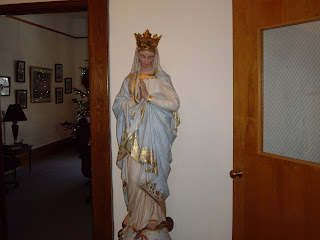
Christmas is coming here at the monastery. Yesterday we put up the manger. It is a manger that reflects our place in the world. It is made of thin branches to look something like a log cabin. Evergreen boughs are then used to decorate it all around. A painted scene of an angel announcing good news provides the backdrop.
Then this morning we had the grand procession immediately after Morning Prayer.
Several sisters went into a closet and carefully brought out all the actors in the divine play. Sr. Clarissa stood in from of the manger and took each statue and carefully placed it in the tableaux. There are sheep, shepherds, Mary and Joseph, a crib and finally, in the crowning moment Baby Jesus is placed in the crib.
It has taken me a while to get used to our nativity scene. I confess (and ask absolution) for my comments that it looked like we had “the little manger in the north woods.” Somehow it seemed so culturally incorrect, the very Northern European looking holy family, a manger that might reflect Idaho but not Bethlehem, not to mention some very odd looking sheep who seemed poised to gaze adoringly at the child.
But I have finally figured out (I’ll admit I’m a slow learner) that what I had seen as “cultural incorrectness” is precisely the point. If we re-create a scene from history, something from far-off, long-ago Bethlehem, then we can feel like we are off the hook. If the manger is only history then the birth of Christ happened far from our modern concerns. But that isn’t how it works. God is being born again into our culture, our time, our lives. Christ is being born again, now, here, in our lives. The vulnerability of God, the incarnation, takes on our flesh. The baby in the manger isn’t only a story in history, it is a story of today. The manger is in Idaho, the manger is in your heart.
As if that all wasn’t enough it is true that Christ is still being born on the margins. God comes in unexpected, difficult guises and is recognized by people who are not recognized by society. Jesus was born in the middle of nowhere in a cow stall. Where is he being born today? Who are the people we ignore, look down on, don’t have time for? What are the aspects of our deepest selves that we try to ignore, suppress or deny? Be careful, those are the places of incarnation.
So now I think that perhaps the problem is not that our traditional manger scene with evergreens and pink-cheeked babies is culturally incorrect but that it is not culturally incorrect enough. Maybe those of us who are sometimes slow to grasp the meaning of the Incarnation need something a little more shocking. Maybe the manger needs to have characters who look oddly like the people I live with in a stable with two twin towers.
That’s the point isn’t it? Wherever we are to say: Behold, God is born in our midst.

